Abstract
The effects of 5-carboxamide tryptamine, which activates non-5-hydroxytryptamine2-'atypical' receptors for 5-hydroxytryptamine (5-HT) in the dog saphenous vein, was studied on the complete distribution of cardiac output and common carotid blood flow in anaesthetized pigs. The drug was infused for 10 min at the rate of 0.025, 0.1 and 0.4 micrograms kg-1 min-1 either intravenously (cardiac output distribution) or intra-arterially (carotid distribution). 5-Carboxamide tryptamine decreased arterial blood pressure due to a reduction of cardiac output. This reduction was confined to its arteriovenous anastomotic component; the component used for the tissue perfusion (nutrient part) in fact increased. Similar changes were observed in the carotid blood flow distribution. Vasodilation was observed in several tissues, but the skin, ears and stomach responded most prominently. The effects of 5-carboxamide tryptamine on the carotid distribution were not significantly modified by cyproheptadine (1 mg kg-1). It is concluded that, like 5-HT, 5-carboxamide tryptamine constricts arteriovenous anastomoses and dilates arterioles by activating non-5-HT2-'atypical' receptors. These 'atypical' 5-HT receptors appear to be of the 5-HT1 type since both 5-carboxamide tryptamine and BEA 1654, a new piperazine derivative, produced similar vascular effects in the carotid bed of the pig and also showed a high and selective affinity for the 5-HT1 binding sites.
Full text
PDF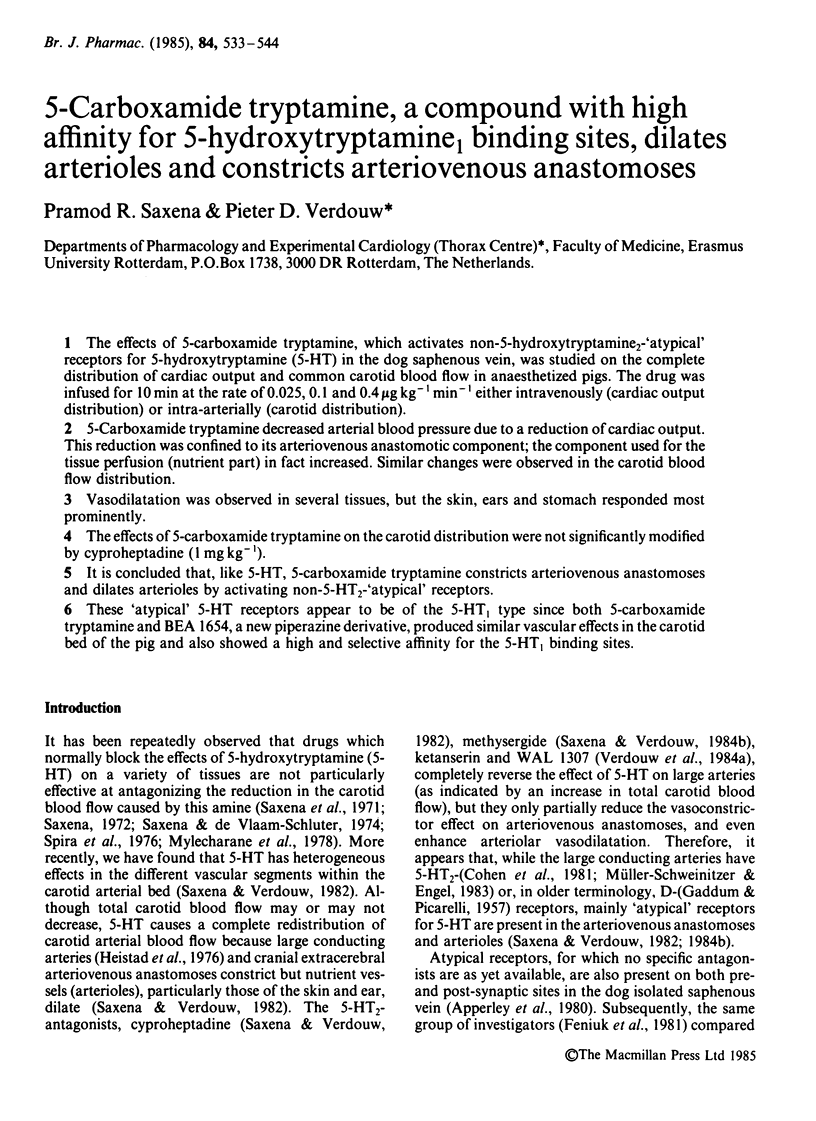
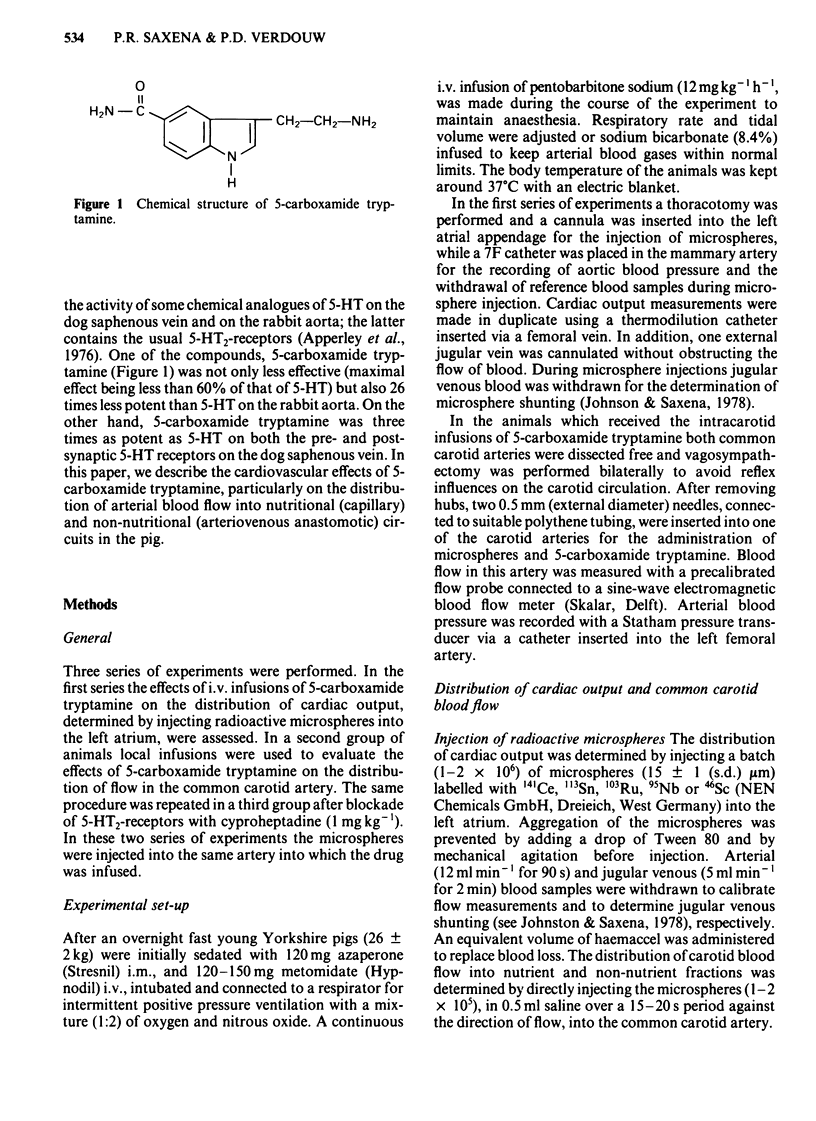
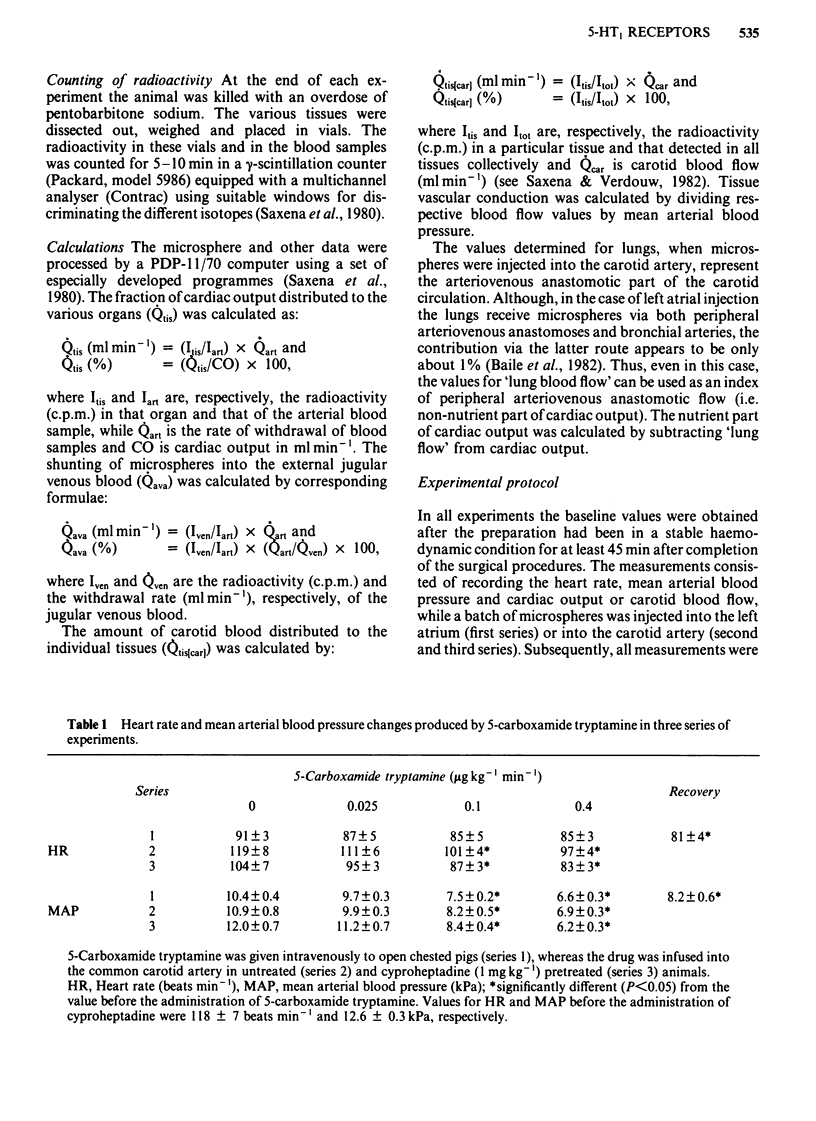
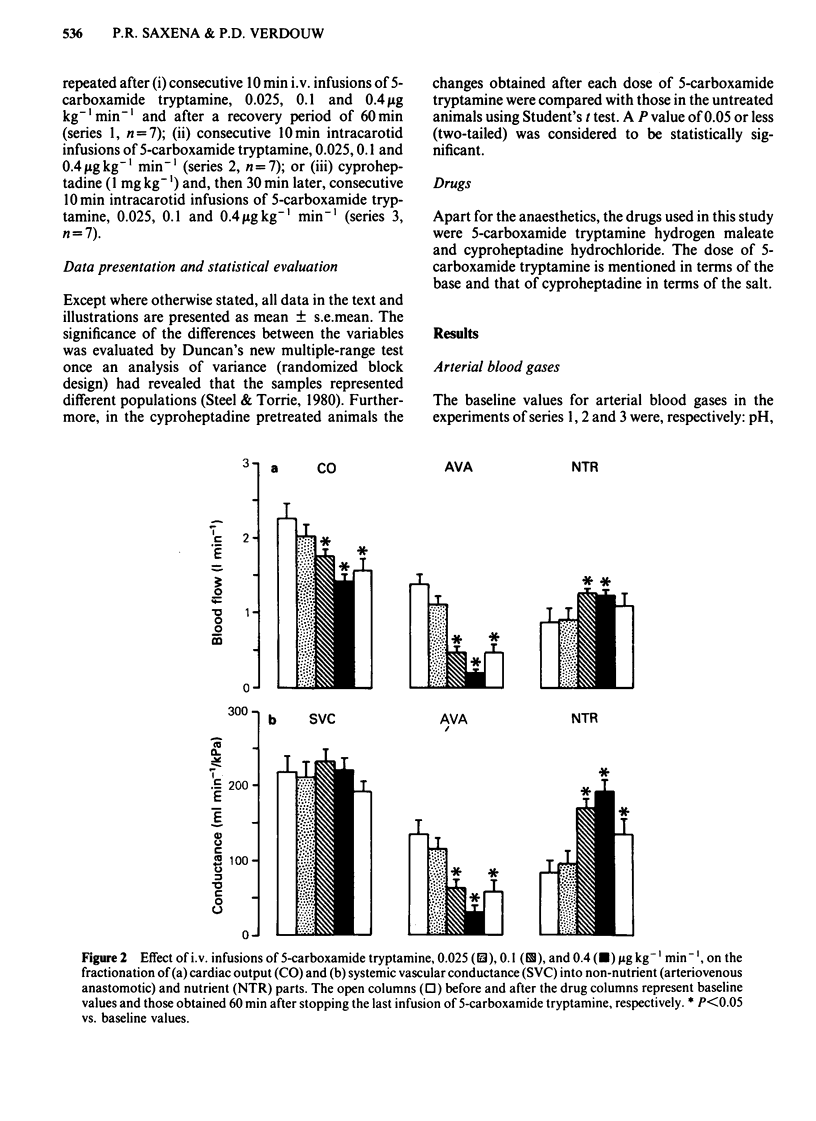
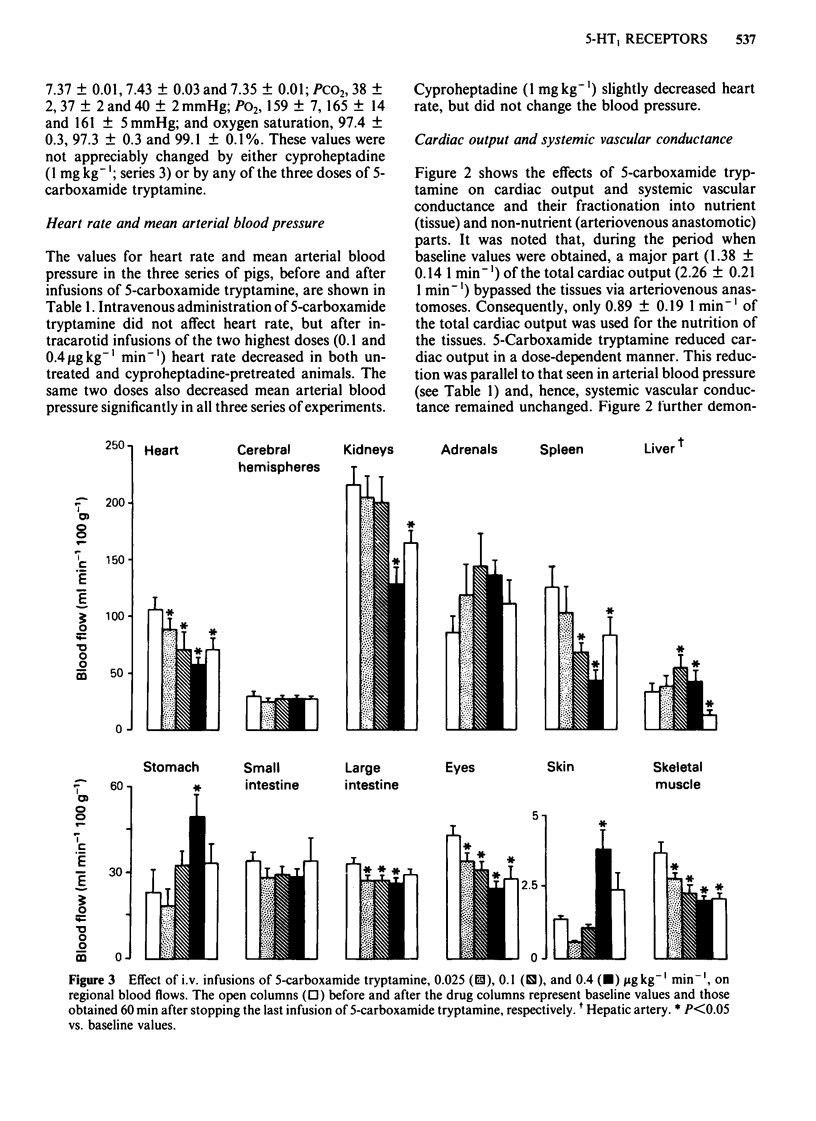
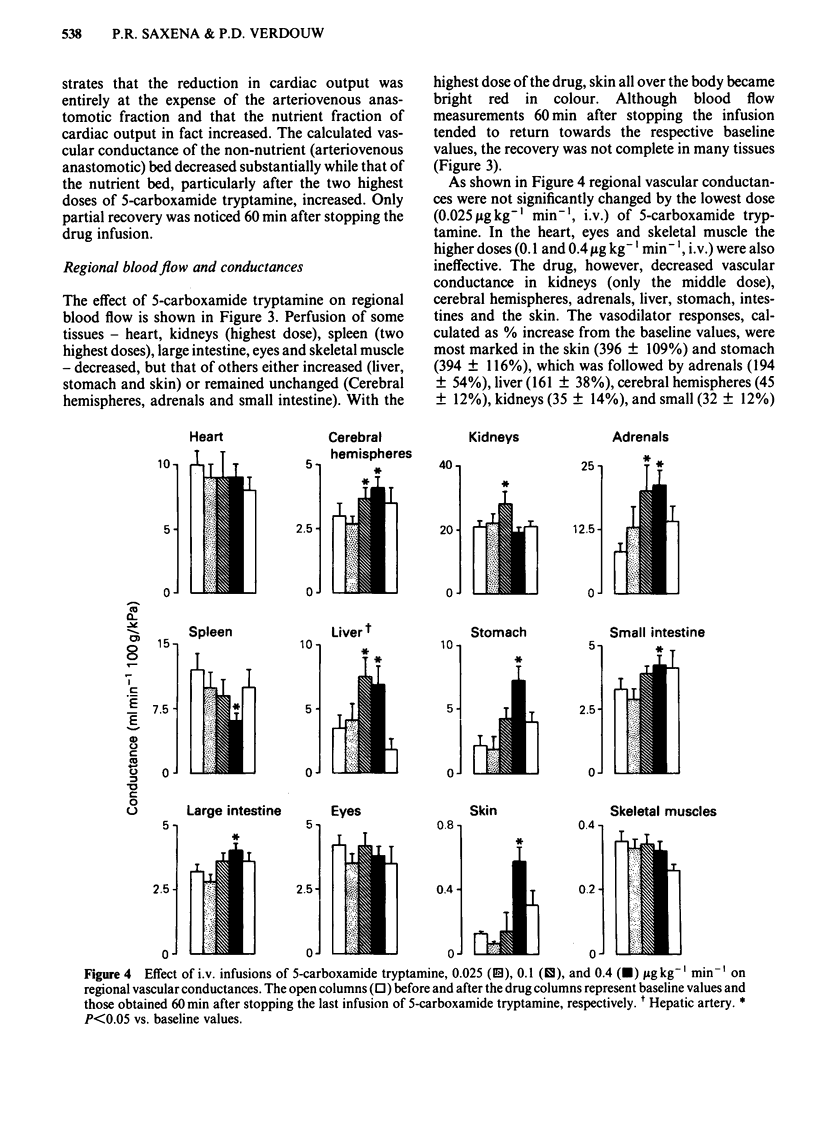
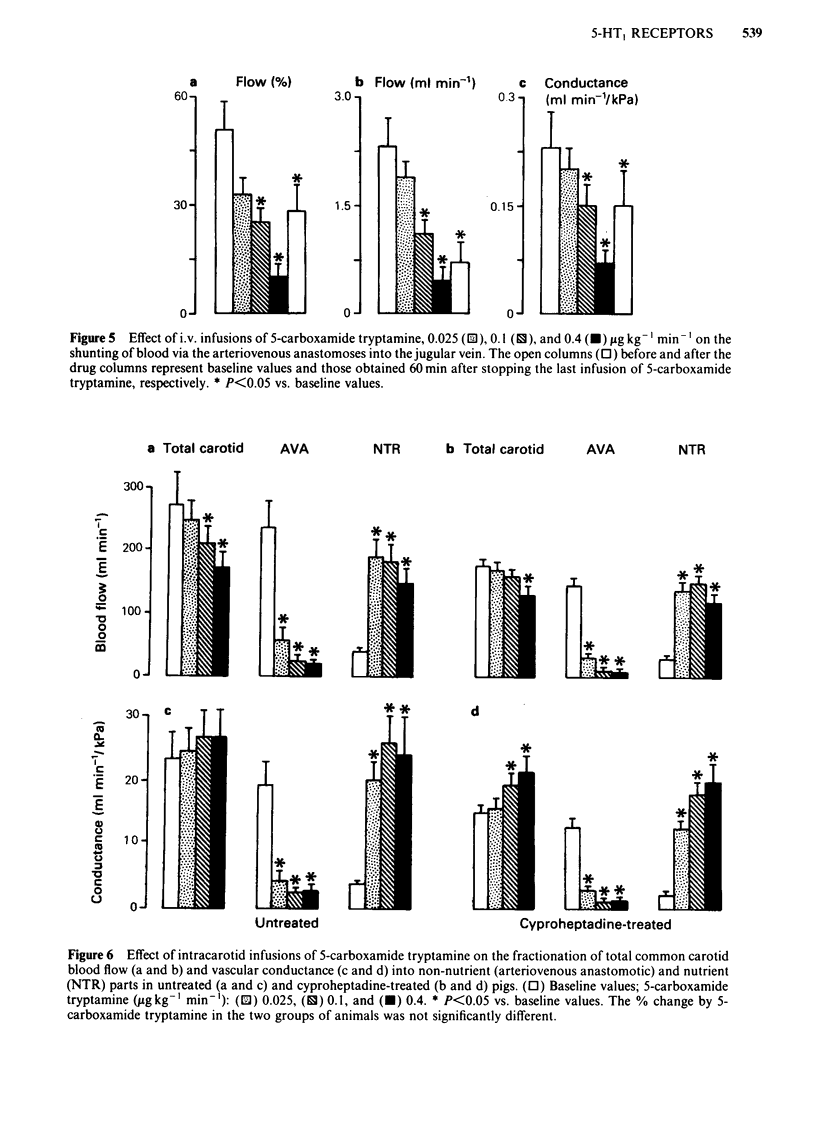
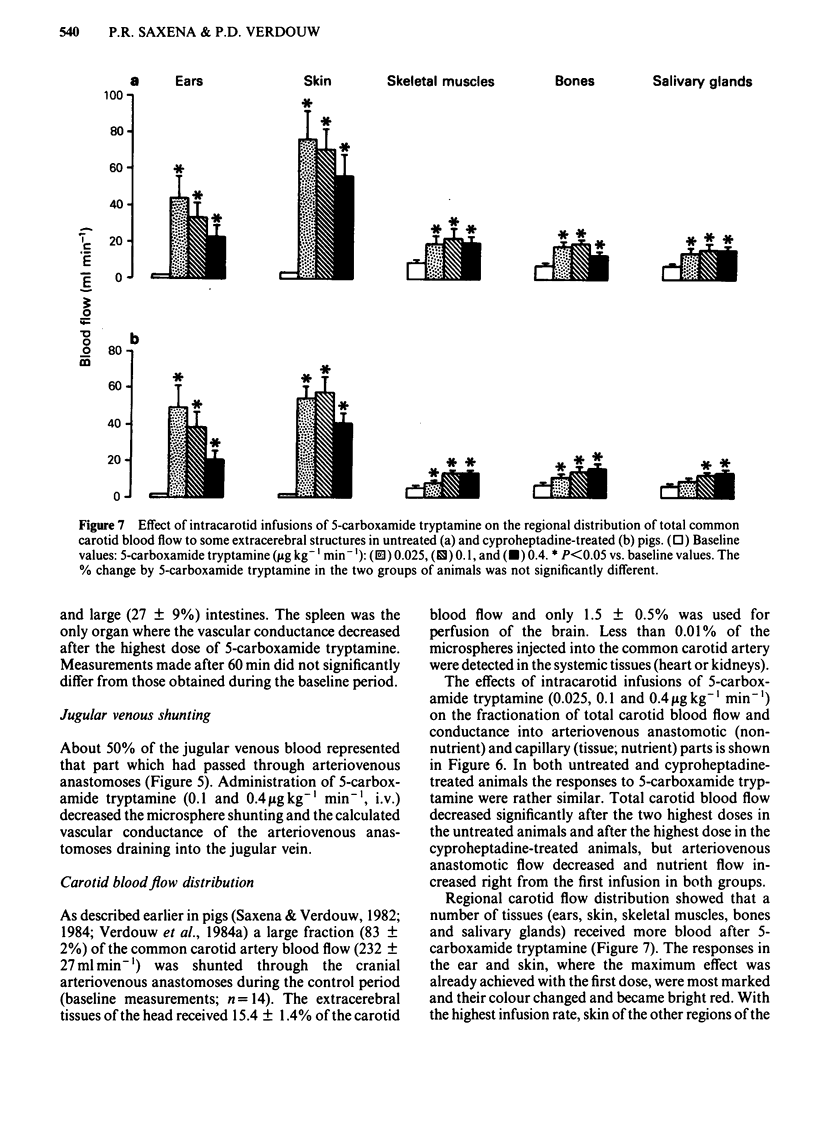
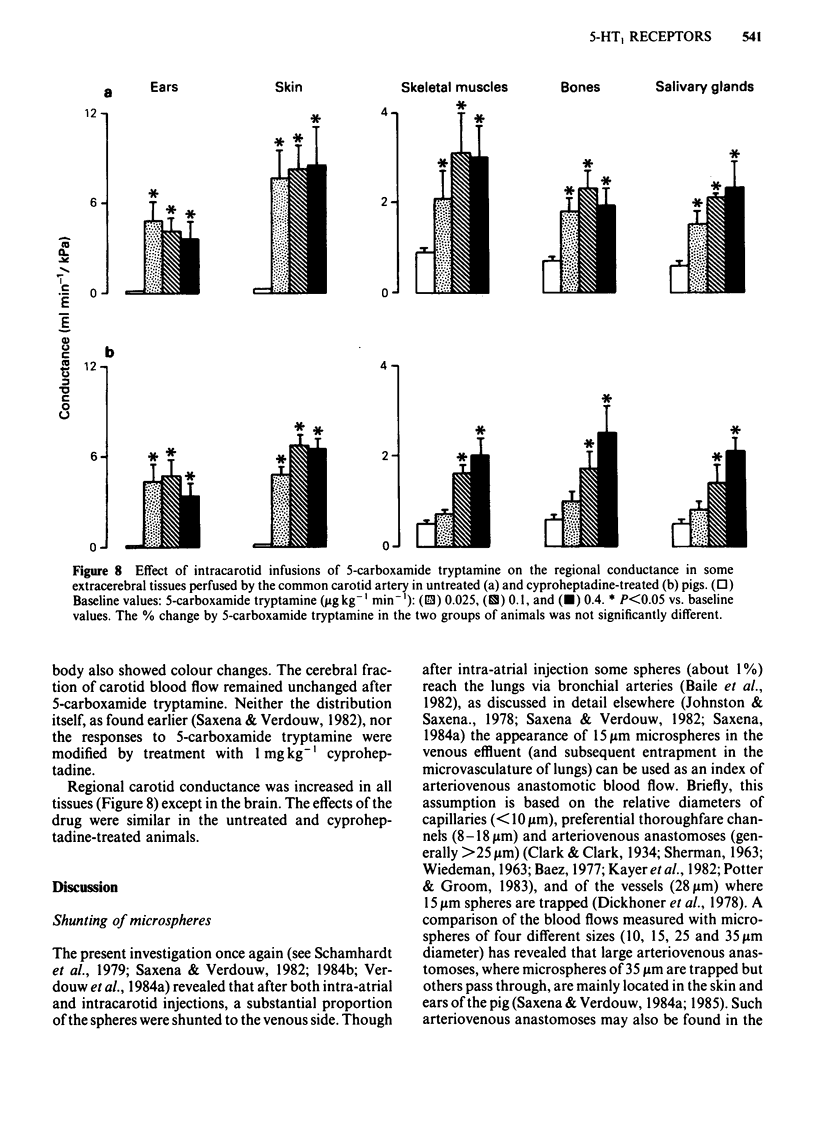
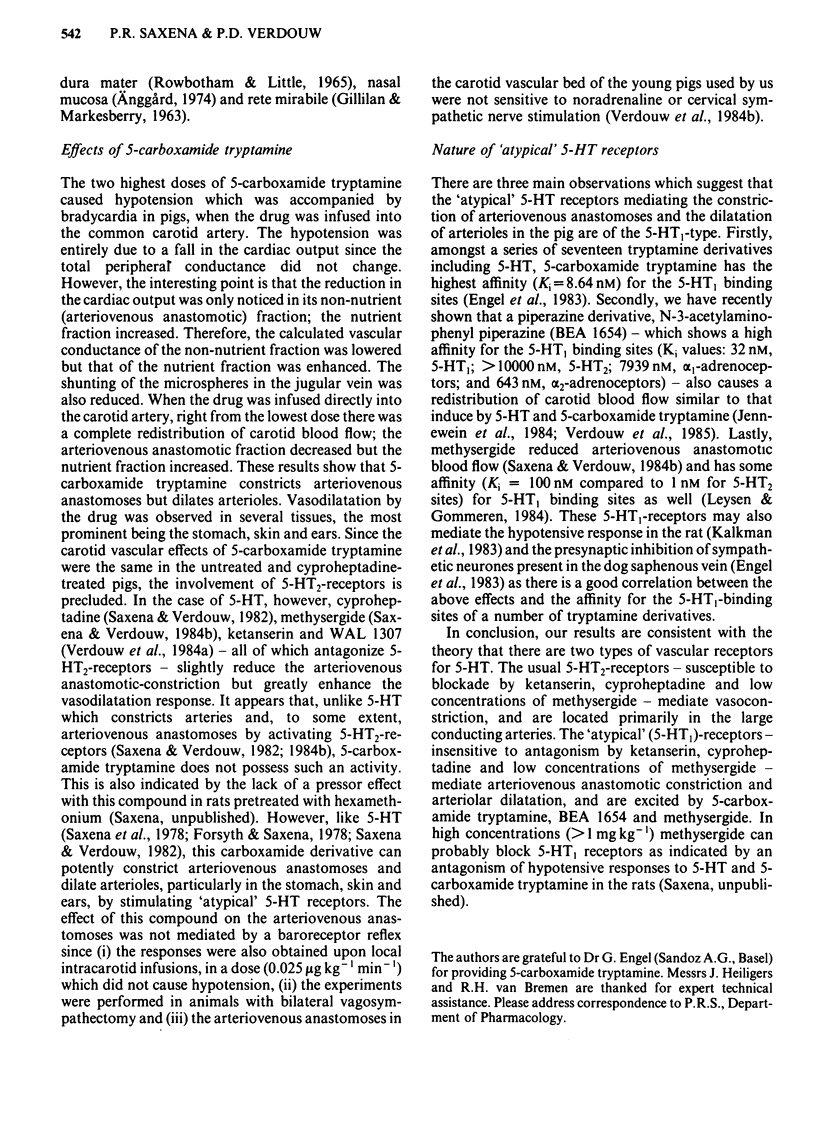
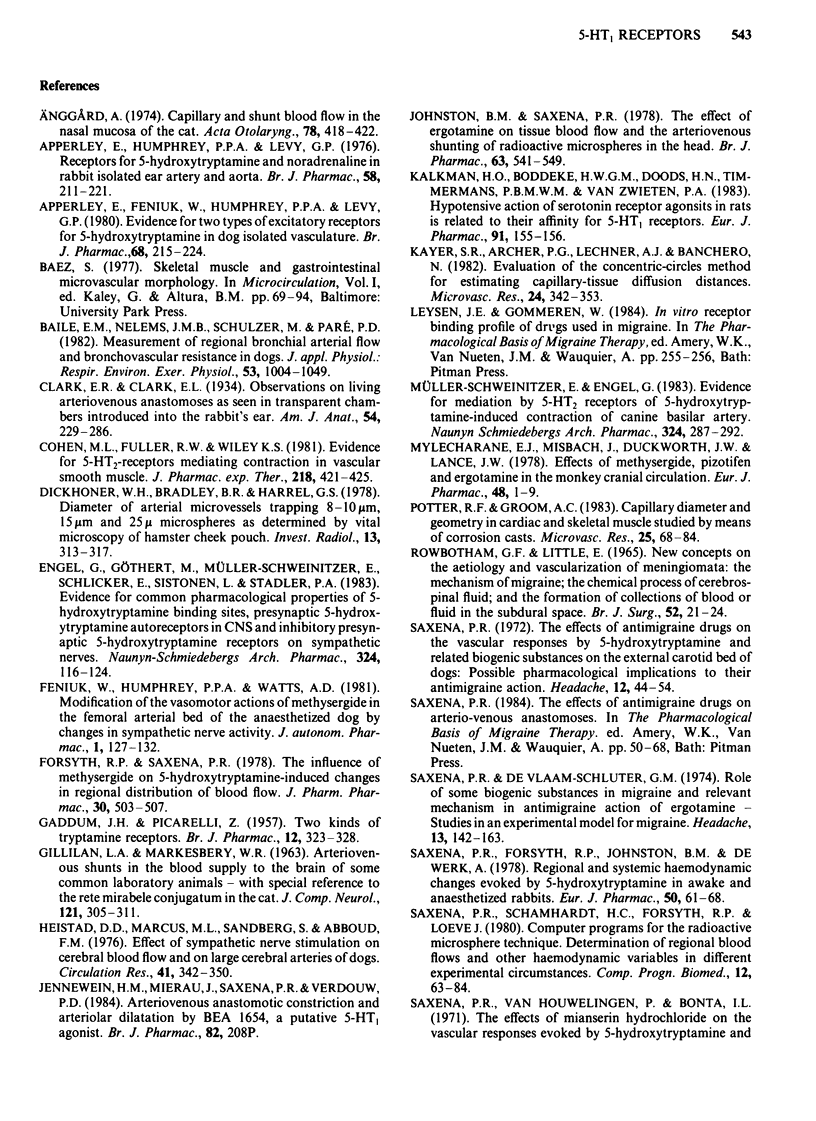
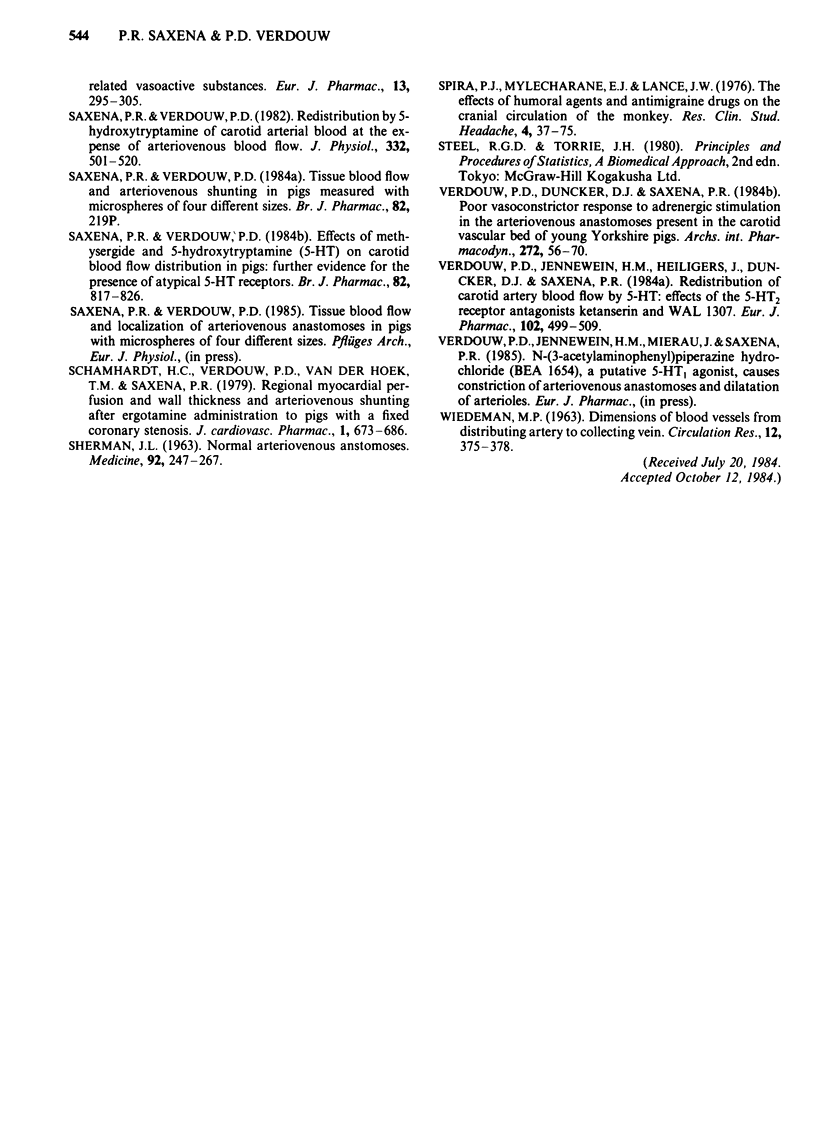
Selected References
These references are in PubMed. This may not be the complete list of references from this article.
- Anggard A. Capillary and shunt blood flow in the nasal mucosa of the cat. Acta Otolaryngol. 1974 Nov-Dec;78(5-6):418–422. [PubMed] [Google Scholar]
- Apperley E., Feniuk W., Humphrey P. P., Levy G. P. Evidence for two types of excitatory receptor for 5-hydroxytryptamine in dog isolated vasculature. Br J Pharmacol. 1980 Feb;68(2):215–224. doi: 10.1111/j.1476-5381.1980.tb10410.x. [DOI] [PMC free article] [PubMed] [Google Scholar]
- Apperley E., Humphrey P. P., Levy G. P. Receptors for 5-hydroxytryptamine and noradrenaline in rabbit isolated ear artery and aorta. Br J Pharmacol. 1976 Oct;58(2):211–221. doi: 10.1111/j.1476-5381.1976.tb10398.x. [DOI] [PMC free article] [PubMed] [Google Scholar]
- Baile E. M., Nelems J. M., Schulzer M., Paré P. D. Measurement of regional bronchial arterial blood flow and bronchovascular resistance in dogs. J Appl Physiol Respir Environ Exerc Physiol. 1982 Oct;53(4):1044–1049. doi: 10.1152/jappl.1982.53.4.1044. [DOI] [PubMed] [Google Scholar]
- Cohen M. L., Fuller R. W., Wiley K. S. Evidence for 5-HT2 receptors mediating contraction in vascular smooth muscle. J Pharmacol Exp Ther. 1981 Aug;218(2):421–425. [PubMed] [Google Scholar]
- Dickhoner W. H., Bradley B. R., Harell G. S. Diameter of arterial microvessels trapping 8--10 micron, 15 micron and 25 micron microspheres as determined by vital microscopy of the hamster cheek pouch. Invest Radiol. 1978 Jul-Aug;13(4):313–317. doi: 10.1097/00004424-197807000-00007. [DOI] [PubMed] [Google Scholar]
- Engel G., Göthert M., Müller-Schweinitzer E., Schlicker E., Sistonen L., Stadler P. A. Evidence for common pharmacological properties of [3H]5-hydroxytryptamine binding sites, presynaptic 5-hydroxytryptamine autoreceptors in CNS and inhibitory presynaptic 5-hydroxytryptamine receptors on sympathetic nerves. Naunyn Schmiedebergs Arch Pharmacol. 1983 Sep;324(2):116–124. doi: 10.1007/BF00497016. [DOI] [PubMed] [Google Scholar]
- Feniuk W., Humphrey P. P., Watts A. D. Modification of the vasomotor actions of methysergide in the femoral arterial bed of the anaesthetized dog by changes in sympathetic nerve activity. J Auton Pharmacol. 1981 Mar;1(2):127–132. doi: 10.1111/j.1474-8673.1981.tb00504.x. [DOI] [PubMed] [Google Scholar]
- Forsyth R. P., Saxena P. R. The influence of methysergide on 5-hydroxytryptamine-induced changes in regional distribution of blood flow. J Pharm Pharmacol. 1978 Aug;30(8):503–507. doi: 10.1111/j.2042-7158.1978.tb13303.x. [DOI] [PubMed] [Google Scholar]
- GADDUM J. H., PICARELLI Z. P. Two kinds of tryptamine receptor. Br J Pharmacol Chemother. 1957 Sep;12(3):323–328. doi: 10.1111/j.1476-5381.1957.tb00142.x. [DOI] [PMC free article] [PubMed] [Google Scholar]
- GILLILAN L. A., MARKESBERY W. R. ARTERIOVENOUS SHUNTS IN THE BLOOD SUPPLY TO THE BRAINS OF SOME COMMON LABORATORY ANIMALS--WITH SPECIAL ATTENTION TO THE RETE MIRABILE CONJUGATUM IN THE CAT. J Comp Neurol. 1963 Dec;121:305–311. doi: 10.1002/cne.901210302. [DOI] [PubMed] [Google Scholar]
- Heistad D. D., Marcus M. L., Sandberg S., Abboud F. M. Effect of sympathetic nerve stimulation on cerebral blood flow and on large cerebral arteries of dogs. Circ Res. 1977 Sep;41(3):342–350. doi: 10.1161/01.res.41.3.342. [DOI] [PubMed] [Google Scholar]
- Johnston B. M., Saxena P. R. The effect of ergotamine on tissue blood flow and the arteriovenous shunting of radioactive microspheres in the head. Br J Pharmacol. 1978 Jul;63(3):541–549. doi: 10.1111/j.1476-5381.1978.tb07810.x. [DOI] [PMC free article] [PubMed] [Google Scholar]
- Kalkman H. O., Boddeke H. W., Doods H. N., Timmermans P. B., Van Zwieten P. A. Hypotensive activity of serotonin receptor agonists in rats is related to their affinity for 5-HT1 receptors. Eur J Pharmacol. 1983 Jul 15;91(1):155–156. doi: 10.1016/0014-2999(83)90382-5. [DOI] [PubMed] [Google Scholar]
- Kayar S. R., Archer P. G., Lechner A. J., Banchero N. Evaluation of the concentric-circles method for estimating capillary-tissue diffusion distances. Microvasc Res. 1982 Nov;24(3):342–353. doi: 10.1016/0026-2862(82)90021-8. [DOI] [PubMed] [Google Scholar]
- Mylecharane E. J., Spira P. J., Misbach J., Duckworth J. W., Lance J. W. Effects of methysergide, pizotifen and ergotamine in the monkey cranial circulation. Eur J Pharmacol. 1978 Mar 1;48(1):1–9. doi: 10.1016/0014-2999(78)90038-9. [DOI] [PubMed] [Google Scholar]
- Müller-Schweinitzer E., Engel G. Evidence for mediation by 5-HT2 receptors of 5-hydroxytryptamine-induced contraction of canine basilar artery. Naunyn Schmiedebergs Arch Pharmacol. 1983 Dec;324(4):287–292. doi: 10.1007/BF00502625. [DOI] [PubMed] [Google Scholar]
- Potter R. F., Groom A. C. Capillary diameter and geometry in cardiac and skeletal muscle studied by means of corrosion casts. Microvasc Res. 1983 Jan;25(1):68–84. doi: 10.1016/0026-2862(83)90044-4. [DOI] [PubMed] [Google Scholar]
- ROWBOTHAM G. F., LITTLE E. NEW CONCEPTS ON THE AETIOLOGY AND VASCULARIZATION OF MENINGIOMATA; THE MECHANISM OF MIGRAINE; THE CHEMICAL PROCESSES OF THE CEREBROSPINAL FLUID; AND THE FORMATION OF COLLECTIONS OF BLOOD OR FLUID IN THE SUBDURAL SPACE. Br J Surg. 1965 Jan;52:21–24. doi: 10.1002/bjs.1800520105. [DOI] [PubMed] [Google Scholar]
- SHERMAN J. L., Jr NORMAL ARTERIOVENOUS ANASTOMOSES. Medicine (Baltimore) 1963 Jul;42:247–267. doi: 10.1097/00005792-196307000-00001. [DOI] [PubMed] [Google Scholar]
- Saxena P. R., Forsyth R. P., Johnston B. M., De Werk A. Regional and systemic haemodynamic changes evoked by 5-hydroxytryptamine in awake and anaesthetized rabbits. Eur J Pharmacol. 1978 Jul 1;50(1):61–68. doi: 10.1016/0014-2999(78)90253-4. [DOI] [PubMed] [Google Scholar]
- Saxena P. R., Schamhardt H. C., Forsyth R. P., Hoeve J. Computer programs for the radioactive microsphere technique. Determination of regional blood flows and other haemodynamic variables in different experimental circumstances. Comput Programs Biomed. 1980 Dec;12(2-3):63–84. doi: 10.1016/0010-468x(80)90053-7. [DOI] [PubMed] [Google Scholar]
- Saxena P. R. The effects of antimigraine drugs on the vascular responses by-5-hydroxytryptamine and related biogenic substances on the external carotid bed of dogs: possible pharmacological implications to their antimigraine action. Headache. 1972 Jul;12(2):44–54. doi: 10.1111/j.1526-4610.1972.hed1202044.x. [DOI] [PubMed] [Google Scholar]
- Saxena P. R., Verdouw P. D. Effects of methysergide and 5-hydroxytryptamine on carotid blood flow distribution in pigs: further evidence for the presence of atypical 5-HT receptors. Br J Pharmacol. 1984 Aug;82(4):817–826. doi: 10.1111/j.1476-5381.1984.tb16478.x. [DOI] [PMC free article] [PubMed] [Google Scholar]
- Saxena P. R., Verdouw P. D. Redistribution by 5-hydroxytryptamine of carotid arterial blood at the expense of arteriovenous anastomotic blood flow. J Physiol. 1982 Nov;332:501–520. doi: 10.1113/jphysiol.1982.sp014427. [DOI] [PMC free article] [PubMed] [Google Scholar]
- Saxena P. R., de Vlaam-Schluter G. M. Role of some biogenic substances in migraine and relevant mechanism in antimigraine action of ergotamine--studies in an experimental model for migraine. Headache. 1974 Jan;13(4):142–163. doi: 10.1111/j.1526-4610.1974.hed1304142.x. [DOI] [PubMed] [Google Scholar]
- Saxena P. R., van Houwelingen P., Bonta I. L. The effects of mianserin hydrochloride on the vascular responses evoked by 5-hydroxytryptamine and related vasoactive substances. Eur J Pharmacol. 1971;13(3):295–305. doi: 10.1016/0014-2999(71)90218-4. [DOI] [PubMed] [Google Scholar]
- Schamhardt H. C., Verdouw P. D., van der Hoek T. M., Saxena P. R. Regional myocardial perfusion and wall thickness and arteriovenous shunting after ergotamine administration to pigs with a fixed coronary stenosis. J Cardiovasc Pharmacol. 1979 Nov-Dec;1(6):673–686. doi: 10.1097/00005344-197911000-00008. [DOI] [PubMed] [Google Scholar]
- Spira P. J., Mylecharane E. J., Lance J. W. The effects of humoral agents and antimigraine drugs on the cranial circulation of the monkey. Res Clin Stud Headache. 1976;4:37–75. [PubMed] [Google Scholar]
- Verdouw P. D., Duncker D. J., Saxena P. R. Poor vasoconstrictor response to adrenergic stimulation in the arteriovenous anastomoses present in the carotid vascular bed of young Yorkshire pigs. Arch Int Pharmacodyn Ther. 1984 Nov;272(1):56–70. [PubMed] [Google Scholar]
- Verdouw P. D., Jennewein H. M., Heiligers J., Duncker D. J., Saxena P. R. Redistribution of carotid artery blood flow by 5-HT: effects of the 5-HT2 receptor antagonists ketanserin and Wal 1307. Eur J Pharmacol. 1984 Jul 20;102(3-4):499–509. doi: 10.1016/0014-2999(84)90571-5. [DOI] [PubMed] [Google Scholar]
- WIEDEMAN M. P. Dimensions of blood vessels from distributing artery to collecting vein. Circ Res. 1963 Apr;12:375–378. doi: 10.1161/01.res.12.4.375. [DOI] [PubMed] [Google Scholar]


